#pear shaped puffball
Photo


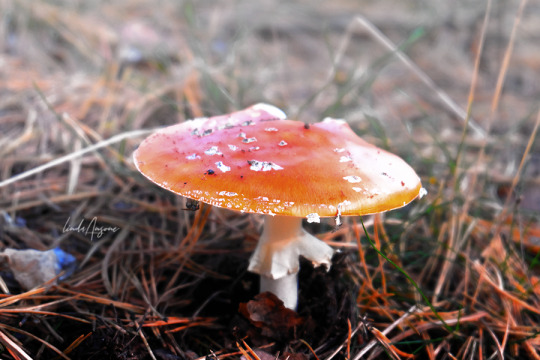


#autumn#fall#autumnal#woods#mushrooms#fungi#flammulina#Amanita muscaria#fly agaric#Pear-shaped puffball#fern#nature#nature photography#latvia#original photography#photographers on tumblr
279 notes
·
View notes
Text
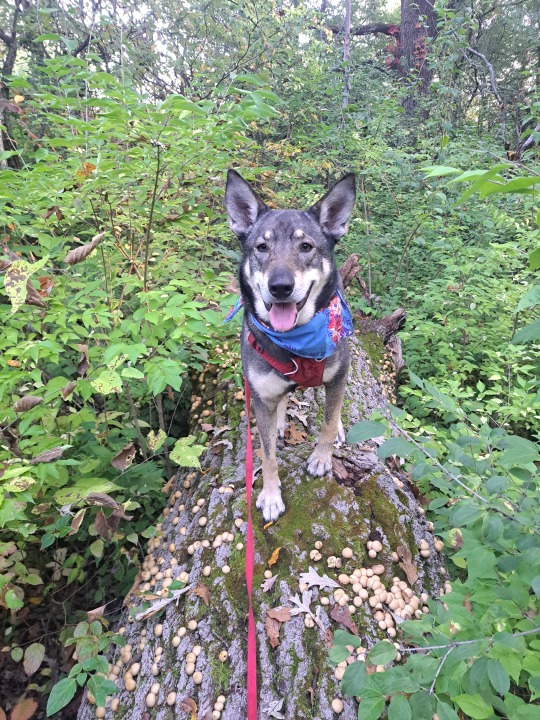
We did find a bunch of stump puffballs, but they were too old to eat
23 notes
·
View notes
Text

Lycoperdon pyriforme, probably.
#Bruce Trail#Cape Chin#Niagara Escarpment#Bruce Peninsula#Bruce County#Ontario#Canada#hiking#hiking trail#forest#trees#wilderness#outdoors#mushroom#mycology#fungus#Lycoperdon pyriforme#pear-shaped puffball#photography#digital photography#DSLR#Canon 6D#photographers on Tumblr
11 notes
·
View notes
Photo

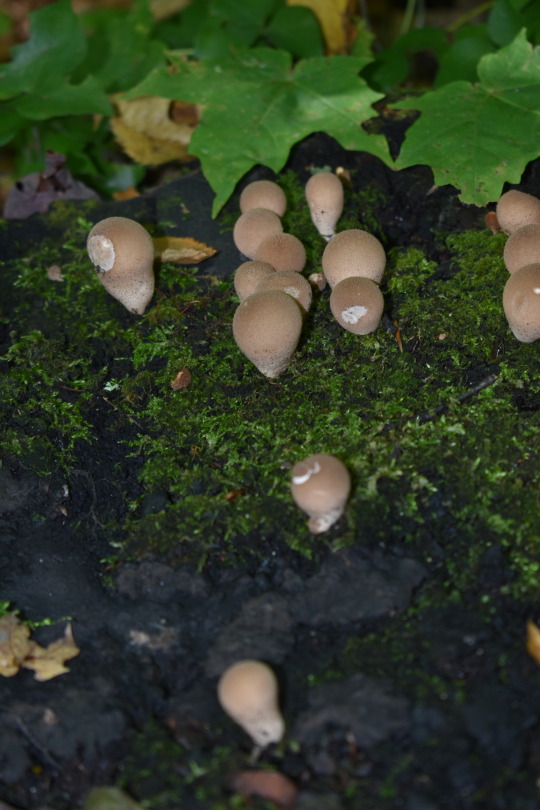
Pear-shaped Puffball
Apioperdon pyriforme
Lycoperdaceae
Photographs taken on September 30, 2022, at Scenic Caves Nature Adventures, The Blue Mountains, Ontario, Canada.
#wildflowers of southern ontario#Pear-shaped Puffball#puffball#Apioperdon pyriforme#Apioperdon#Lycoperdaceae#fungi#Scenic Caves Nature Adventures#Scenic Caves#The Blue Mountains#Blue Mountains#Ontario#Canada
8 notes
·
View notes
Text

#nature#nature core#nature photography#nature photos#naturecore#original photo blog#north#woods#apioperdon pyriforme#pear-shaped puffball
2 notes
·
View notes
Text
Chozo Headcanons: Eggs and the Chicks Inside Them

Egg! I painted a few Chozo eggs as part of a warm-up, so I decided to jot down a few thoughts about their enigmatic little puffball children while eggs are on the mind.
This post talks about the physiological structure of the eggs of four different tribes, what Chozo babies look like + their early development, cultural symbolism surrounding the egg, visual references, and more. I ended up having a lot more to say than I initially realized, and elaborated on some things I've discussed in previous posts, so strap in for a fun ride.
Chozo eggs first develop within the laying parent's ovary sans the shell: the shell only begins to develop in the oviduct after fertilization. If the egg(s) remain unfertilized by the time the parent's laying cycle ends, they will be reabsorbed. Egg synthesis takes precious energy and nutrients: the body is a well-oiled machine, and Chozo can't afford to waste any resources in this economy! The laying of infertile eggs is usually tied to poor health and hormonal imbalance.
Fertilized eggs hatch within 5 months of being laid. Most individuals lay one or two eggs per clutch. Three isn't uncommon, and four is considered a lot, but not terribly absurd. The most prolific individuals can lay up to five eggs. This is incredibly uncommon and not ideal, but not unheard of: there's at least literature that exists to support the parents of five-egg clutches.
Some tribes produce larger eggs than others: general rule of thumb is the larger the eggs, the smaller the clutch.
It is normal for parents to fashion a keepsake from the pieces of a hatchling's shell. If they can locate it after it falls off, the child's egg tooth is another common memento.
The Tribes and their Eggs
The Chozo tribes differ in many ways, including the morphology of their eggs.
Thoha eggs are smooth and tend to be a solid color. They are typically pale in tone with a sturdy shell and a slight, evenly tapered form. Color ranges tend to lie on the colder end of the spectrum.
The Thiloo tribe produces large, vaguely pear-shaped eggs with thick shells and hearty yolks. Their surface is mildly rough with raised granules. Coloration ranges from creamy whites to pale yellows.
The Mawkin are many and diverse: this fact is reflected in their eggs. Their shells can be pale blue, green, or yellow, with blue being the least common and yellow/cream being the most abundant. Mawkin shells are hard and porous. They are noticeably porous, but not quite as rough as the Thiloo.
Hatzu eggs are large, round, and exceptionally smooth—so much so that the unaffiliated might think they were made of glass! But no: their shells are indeed porous, just as the eggs of any other tribe. They lay blue eggs with varying degrees of vibrancy: some are very lightly speckled.
The Hatzu and Thiloo are both one-egg-per-clutch tribes: doubles are unheard of, and triplets are pretty much biologically impossible.

The eggs from above lined up: this time, they're to scale. Thoha and Mawkin eggs are the same size on average, though exact shape and size are dependent on the individual. Hatzu and Thiloo eggs are among the largest produced by any of the tribes.
Thoha
Thoha eggs are beautiful in their simplicity. Their shells are often a light variation of blue, grey, green, or purple with a glossy surface. Thoha eggs are of what one might consider the "standard size" for Chozo eggs: most tribes' eggs are around their height, though exact width and shape vary.

Thoha nestlings are the image of your typical altricial Chozo newborn: blind and near-naked at birth, it takes ten days for them to open their eyes and two weeks for them to gain a full covering of soft natal down.
Thoha parents are diligent and focused on allowing their children the quaint joys of childhood while fostering a love of learning and a sense of curiosity. They take advantage of every learning opportunity, and though every individual is different, they have a reputation for being some of the most patient teachers. A Thoha child's early life is filled with new sensory experiences and engaging puzzle-toys designed to encourage motor skills and entertain the use of different sections of the brain.
Thiloo
Large eggs for large babies! The Thiloo homeworld is frigid and unforgiving: their hatchlings are known for having some of the largest post-natal measurements out of all the tribes. Thiloo chicks are taller and heavier than the infants of most other tribes, and they grow exponentially within the first three months of their lives. Thiloo babies need to be bulky to survive the planet's eternal winter. Food isn't always available: reliable fat stores will keep them warm throughout the year, supplying them with the energy they need to grow even when sustenance is scarce.
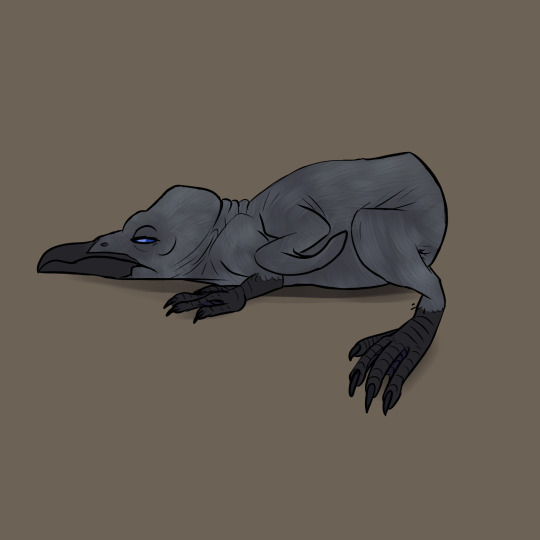
Baby Thiloo are rotund with comical limb proportions. They are born semi-altricial: they rely on their parents for food, but are covered with down upon hatching rather than being completely featherless. This downy covering thickens as they age, and they learn to swim when they're old enough to molt: after their first molt, they gain waterproof feathers.
Thiloo infants tend to pack on the down pretty quickly compared to other Chozo: it takes three days for a newborn Thiloo chick to gain a full, fuzzy coat of down compared to the Mawkin's two weeks. Thiloo infants also open their eyes within the first 24 hours after hatching.
How do these babies get so big? The answer lies within the parent that laid the egg. To start, the typical Thiloo diet is packed full of nutrients and minerals that are a boon to embryonic development, so their yolks are highly nutritious whether they're planning to conceive or not. The marine animals that make up a large portion of their home menu are simply rich in the kind of fats and minerals that would supply an egg with a healthful yolk.
Additionally, Thiloo Chozo are genetically predisposed to being tall: I've mentioned previously that the Mawkin tend to be a tall tribe, and the Thiloo are no exception. However, Thiloo nestlings are far taller than the newborns of tribes whose children are wholly altricial at birth. If you saw Mawkin and Thiloo hatchlings side by side, you'd take one look at the Thiloo baby and say "I bet that one's going to grow up to be way taller than the other kid". And you would only be kind of wrong! The Thiloo child will most definitely grow up to be a tall order, but the Mawkin child does indeed have the potential to match their arctic friend in height.

A newly hatched Thiloo chick (left) and a newborn Mawkin nestling (right), held by their parents.
Thiloo parents prepare for laying, and they do so diligently. It's common practice to work with nutritionists and fertility experts prior to conception to seek out their own nutritional deficits and carefully curate a plan to pack their egg's yolk with as many chick-buffing nutrients as possible. The laying parent will fill up on fish from deep within glacier caves to supply their chick with a generous helping of iron, salts and other trace minerals that encourage easy growth in infants of their particular biology. Many blood tests are conducted throughout this period to ensure that speculated conditions are optimal for embryonic development.
The Thiloo are adept at crafting a yolk packed full of protein, fats and other nutrients to promote sufficient growth in their hatchlings. Some parents quite literally engineer their children to be as healthy and hefty as possible to ensure that they thrive in the arctic clime! Cute, bulky, cold-resistant fur coats can come later: a Thiloo parent's first concern is ensuring their child is prepared for survival right off the bat.
Mawkin
If they're not being incubated the old-fashioned way at home, these rigid eggs are housed within a nursery in the university research complex not far from Dairon (also home to the planet's largest medical center). They are diligently guarded by Mawkin midwives and the warrior-monks who make their home in the cliffs above the clinic. This is a long-standing arrangement that has persisted for centuries: it is at once tradition and an earnest act of community service. In any case, it saves the army from having to set aside a contingent of soldiers to protect the facility from wild animals.
The first illustration does not begin to describe the full breadth of Mawkin egg shape and coloration, but it does give us a peek into the world of pattern variation. Not all Mawkin lay patterned eggs, but the ones who do can put out shells dotted with flecks, speckles and spots. No two eggs are exactly the same, and the patterns manifest as the shell forms within the oviduct.

Some doctors believe these patterns serve as camouflage: a holdover from ancient times, when nests had to be guarded from intrusion by enemy factions who sought to lower the Mawkin predecessors' numbers, as well as predators seeking an easy meal. Others have noted that the dark spots on speckled shells tend to contain a higher volume of calcium, and posit that patterns may serve to reinforce the shell in places where the shell is thinner or otherwise lacking in structural integrity.
Whatever the case, it is agreed upon that patterned eggs are "dyed" with these mineral-laden spots as they rotate within the body during the shell's formation. It is also known that a parent's diet can affect the pattern: an individual who is predisposed to producing patterned eggs can guarantee that the spots on their child's shell will be numerous and richly colored if they keep up with proper calcium intake.
Apart from the posited theories on camouflage and structural benefit, there's not really any reason one would (normally) want to affect the appearance of a laid egg's shell prior to laying.
Hatzu
Another large-egged tribe, Hatzu children are unique among the Chozo in that they are precocial: upon hatching, their eyes are already open, and their bodies are covered in natal feathers. Their children also set themselves apart by their lack of an egg tooth: Hatzu babies kick their way out of the shell with their long legs!

Hatzu children are notable for their ability to walk right off the bat. Their arms can be difficult to see through their forest of fuzzy plumage, and they wave their useless wings around with abandon while playing and frolicking afield. To pick these sprightly chicks up for examination, physicians of their tribe will place a hand or two beneath the child's midriff and lift.
Hatzu children do not opt to cling to the neck or breast of their parents as often as infants from other tribes: they are most likely to request a lift from a trusted adult when they are frightened or anxious.
Though they are wont to run and hop about, Hatzu hatchlings aren't very well coordinated yet: they often trip over their own feet or otherwise fall flat. It takes about two months for Hatzu children to get a better grasp on dextrous use of their arms and hands, and 18 months to perfect the art of walking without risk of falling over.
Cultural Significance of the Egg
The egg as a symbol is loaded with cultural significance: it is the vessel through which Chozo children are born, and the basis from which much of life originates: seeds are eggs, generator cores are eggs, planets are eggs, life is an egg.
The egg is sturdily built, yet delicate: it can weather shock to an extent, but it must be guarded. The egg is a force that sustains not life itself, but the potential for life: the yolk within sustains a future organism that itself holds the potential to live and change the fabric of Now. In sustaining this idea, the yolk itself is a vector for life: the vitality it provides is valuable not just to the cells within its porous cradle, but to many outside it. The yolk and the embryo it feeds could have their vitality, the spark through which all power derives, taken at a moment's notice, be it by wild beasts or thieving others.
The egg itself fosters Potential, through which the essence of Life is given pass to bloom: this makes the egg, by extension, a mechanism responsible for the vectors in which Life originates. The shell is a nest, the nest is a shield, the yolk is the basis which feeds the flame of potential, potential fosters the idea of Life which gives rise to power... which, depending on who you ask, is the spoke that all else revolves upon.
Life is an approximate egg.
This is a paraphrased excerpt of Wise Wing the Elder's Allegory of Becoming, which describes the greater significance of the egg in the context of Chozo culture at large. The egg is a vessel for potential, and potential is the force that ushers life. The original text is pretty dense and kind of goes off the rails into the esoteric, but this should sum up the egg in a nutshell.
Chozo babies are born from eggs: Wise Wing draws a connection between potential and life without directly ascribing life as a quality of the egg itself: the yolk holds the closest association with life, though the egg is still part of the cycle of life at large. Wise Wing is rationalizing the means through which the egg serves as a placeholder in the absence of a more specific or centralized cultural symbol that represents life.
Life is a lot of things, and the egg consists of many parts that each serve their own purpose in renewing life. The egg itself is one small part of the greater concept of Life, and Wise Wing goes in depth about this later... but that's neither here nor there. The egg is a convenient symbol for life and various affiliated concepts: it's the beginning of a Chozo's journey to existence, and the Chozo conflate the Egg with all manner of things that "breathe life" to other things within the universe.
The egg is a cradle, the cradle holds the hatchling. The shell is a shield, the shield is a guardian. Yolk is breath is sustenance is necessary is coveted: Life forms will, will covets the yolk, yolk builds up from simpler things, and will begets power. That's at least the logical hierarchy: the more complicated facets of society and Being originate from the egg.
The yolk is often a metaphor for natural resources and other things that drive people to Act. Predation of eggs by wild beasts who seek to consume all the nutrient-rich bits within becomes an allegory for the origins of conflict. The symbolism surrounding the egg in Chozo culture is about as round as the structure itself: they all feed into each other, everything is a cycle, ideas catalyze actions which have consequences.
The Egg is Potential: Potential drives Life. The egg is often conflated with both subjects.
That's enough talk of broader metaphors: bottom line is the egg is a very significant concept with many faces, and one of these faces is the baseline that branches out into many specific symbols.
As for simpler symbolism: the egg can be used to represent children or indicate that a story's setting is within a place where children are reared. The egg is a symbol of parenthood, fertility, infancy, fragility, youth, new growth, and beginnings.
The egg is particularly notable as a symbol of origin: two Mawkin hero-myths involve midwives hearing the subject of the story belting the ancestral war hymns from within the egg, and the hero bursting from the shell fully grown + armed to the bone respectively. The egg is the figurative and literal beginning of the story in both cases. In other stories, the egg serves as a stand-in for the origin of a person, place, or ordeal. Thoha stories dated before their arrival on Zebes speak of an "Egg of Conflict" from which a great calamity or a period of unrest was born.
I've run my mouth quite a bit on symbolism, but I also have a few words on artistic interpretation of the egg. The egg is a largely rounded form, so simplifying it in pursuit of symbolic depiction or artistic expression is a relatively easy task.
Take for example, the orbs held by certain Chozo statues. The orbs they hold are not literal eggs per se, but they can be (and often are) interpreted that way. The young warrior, upon completing the trial set for them by an elder, proves themselves worthy and claims a new tool to gain proficiency with. In this way, the item sphere "hatches", and the warrior claims the fruit within as an aspect of their personal potential. Not only has the technology hatched from its egg: the warrior has, as well.
Anyways, all Chozo have the innate ability to curl up into a spherical shape like the item sphere, and their admiration for such a form has culminated in the invention of the Morph Ball. Now, powersuit users can curl up into an even more compact orb-shape to fit into far smaller spaces. This is useful for exploration, vent shaft maintenance, and a variety of other tasks.
What to Expect When You're Expecting: a Primer on Baby Chozo
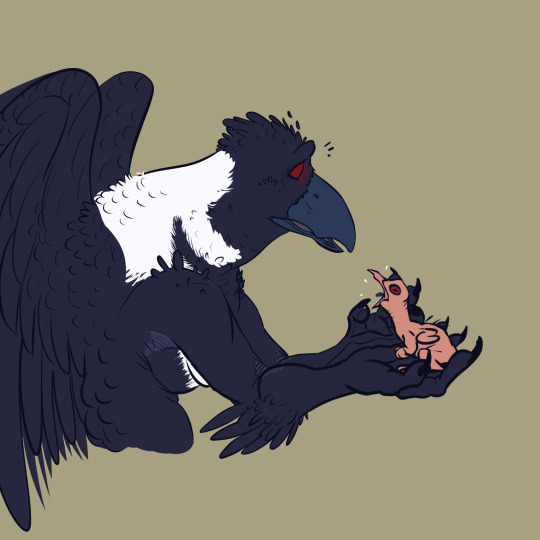
Oh, look: it's a newborn Raven Beak and his father.
Most Chozo children hatch blind and naked or almost featherless. They are altricial, with the exception of the Hatzu: these differences are highlighted in the previous sections. Unless specified, it should be assumed that a given milestone is shared among most tribes, including the Hatzu. The typical Chozo child will open their eyes within ten days of hatching: by two weeks, they are covered in soft down. A Chozo hatchling will spend much of the day sleeping until it reaches two and a half years of age.
Chozo babies are fed by the adults around them, either through regurgitation or breaking the food into appropriately-sized pieces for the hatchling to swallow. Fruits are crushed (usually in the beak) and fed in mushy portions. Small, flaky chunks of larger hocks of meat are scraped with the tip of the beak or a handheld utensil. Small enough insects are caught, incapacitated, and fed whole. Portions of a given meal are set aside in a parent's crop to regurgitate for the child later.

A seven month-old Thoha chick covered in a soft blanket of baby down.
A major factor setting Hatzu children apart from the children of other tribes is their ability to walk from birth: they trot alongside their parents, learning to forage for themselves as they grow. They are still fed by their parents: they can't do everything by themselves, but they have a leg up over other kids in early walking and foraging behaviors. Hatzu chicks will eat bugs off the ground while their parents are talking to other adults: children from other tribes don't have as much freedom with snack choices quite so early on in their lives.
Chozo hatchlings are capable of using their voices from day one, but they begin mimicking the vocalizations made by the adults around them as early as three weeks: this is a child's first foray into speaking, though they will not begin properly repeating full words back at their parents until over a year into their life. The sounds they make at this point are mostly "bird-like": it's the tone and rhythm that counts. Chozo parents will "talk" to their children, encouraging their chirps, trills, peeps, and odd-beaked babble by responding with words or sounds of their own.
It takes about two months for a chick to reach the point where it can independently (and reliably) grasp onto a parent's neck for transportation: this is primarily how the child will get around for the next three years of its life. The fact that they spend many hours sleeping is no deterrent to their grasping: Chozo children are capable of maintaining a steady grip while they rest because the joints in their talons will lock in place at certain positions.
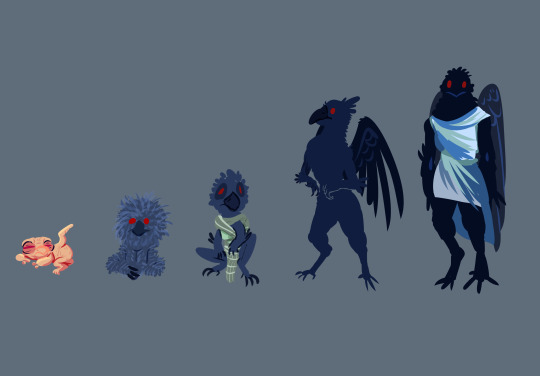
A very loose illustration of plumage progression in a Mawkin individual. It's not exact: but it conveys a few of the different "life stages" in plumage. From left to right, we have a naked newborn nestling, a chick covered in natal down, a child with soft transitional feathers, a juvenile growing into their particular bloodline's striking black hue, and an adult with dark, glossy plumage and fully flight-feathered wings.
Most chicks who are in their first coat of down are much lighter or otherwise very different in coloration than they end up as adults. Some baby Chozo have stripes or spots in select areas that are phased out down the line as they grow into their big bird feathers and start displaying the patterns they've inherited.
Baby Chozo have their first molt at eight months of age: fuzzy chicks shed their coat of natal down and gain a fresh covering of soft transitional feathers (except the Thiloo: their first waterproof plumes grow in at this stage). These are no flight feathers, they're still baby feathers. After the first molt, Chozo children will replace their feathers gradually throughout the year just as adults do. It takes four years for a child's transitional feathers to show distinct genetic markings, twelve years for chicks to transition fully to what we would call "juvenile feathers", and 24 years for an adult Chozo to have an even coat of mature feathers.
By 18 months, most chicks will be able to stand and walk on their own. By two years, a baby's babbling will become more coherent: what were once simply earnest signs of interest in communication transform into almost-recognizable imitations of words. This is when speech education goes into full swing. Speech and motor skills continue to develop, and by four years of age, most children will be capable of speaking coherently to their parents (with the expected differences in vocabulary and communication skills one would see between a small child and an adult).
Bonus: freshly hatched baby Raven Beak.

His voice sounds like if zip ties could chirp.
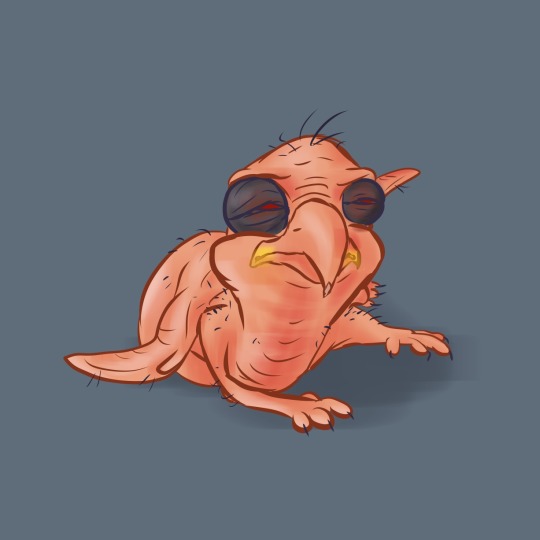
0 month-old Old Man awakes from a nap.
#Chozo#metroid#baby chozo#headcanons#i love newly hatched Raven Beak he's a fucked up meatball child#Tubby Custard-ass baby#my beautiful shriveled ballsack of a child#Mawkin#Thiloo#Thoha#Hatzu#long post#Nimble Talons#gotta tag every mention of Raven Beak's parents
29 notes
·
View notes
Text
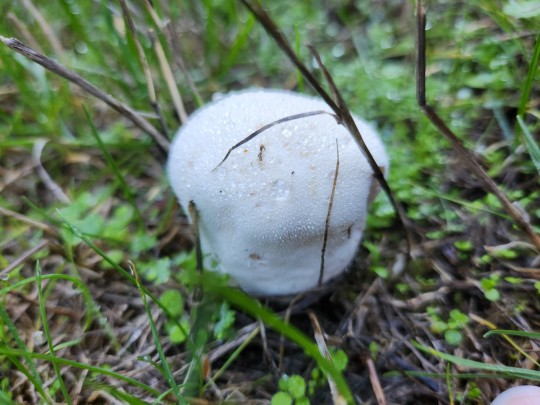

The common puffball/gem-studded puffball (Lycoperdon perlatum) is a pear-shaped edible mushroom. They also seem to have a studded surface, hence the nickname. However, only young fruitbodies should be collected. Young fruitbodies are completely white on the inside with consistent marshmallowly texture. When puffballs are cut in half, there shouldn't be any gills present. (Meaning the shroom in question isn't a puffball) These puffballs tend to grow in groups of 3-10 on average.
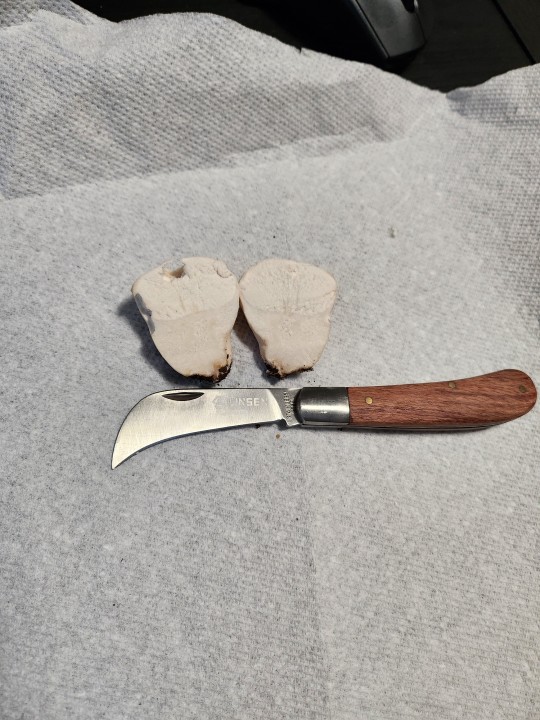
Here is a cross-section of a common puffball found in the PNW. Note the consistent white insides w/o the presence of gills. (Young fly agaric mushrooms can appear to be puffballs, but when cut open, they reveal gills.)
#foraging#forage#puffball#common puffball#mushroom hunting#mushies#mushrooms#puffballs#fungus#pacific northwest#edible shrooms
3 notes
·
View notes
Text
Puffballs--Calvatia and Lycoperdon
Puffballs have neither gills nor pores! They just puff up, mature, go to spore and then fall apart. If you find them at the right time of sporing, you can press on the little ones and the spores will burst through a hole in a cloud of smoke. And the big ones you can punt. Just don't punt puffballs that haven't gone to spore because they won't be able to do so afterward. Eat them or leave them.
All my photos, all unedited. Don't mind the blurry one; it was getting dark and all I had was my cellphone.


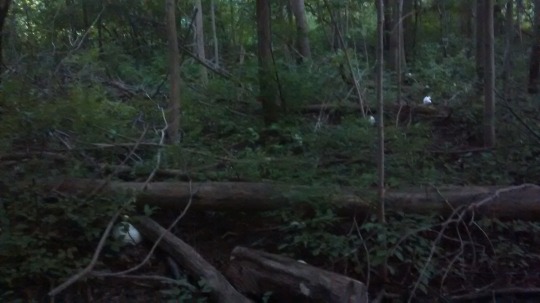
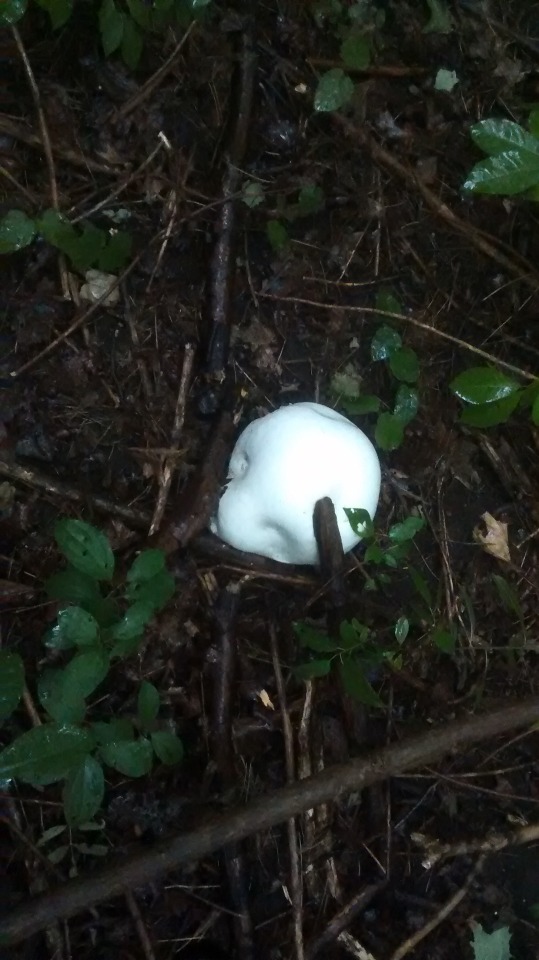
Calvatia giganteus, the giant puffball.
The way I jumped in the air when I found my very first of these. I thought it was likely just a sportsball of some kind, but I investigated to satisfy my curiosity. As I got closer I thought, no, it can't be that, but probably a ball of styrofoam. I was still half-convinced it couldn't be what I was hoping for when I got up to it. Then I put my hands on it and tugged, expecting it to either simply come off the ground or else have some resistance if it was attached. Instead I heard a snap, and I knew immediately what I had in my hands. After my initial victory jump I opened it in half: solid white inside. Cue a secondary victory jump! It wasn't the only in there, but those I left to the forest.
That's not to say there weren't other times when a ton of them were popped up all over the woods! What you see in my bag there wasn't even a quarter of the amount (couldn't get a good photo, unfortunately; it was getting dark and I wanted to grab what I could and get out of the woods).
They have to feel firm to the touch and then you need to open them to see if they're solid white inside. If they're soft or yellowed, it's too late; they'll make you sick, so leave them to the woods. Peel and careful when cleaning as they absorb water very easily. They also have a lot of moisture in them, more than you'd think, and they will cook down. Great in an omelette mix. They're mild enough to use in things like pancakes too.




Lycoperdon pyriforme, the pear-shaped puffball. "Pear-shaped" is what "pyriforme" means, but do you know what "Lycoperdon" means? It means wolf fart. You're welcome.
Anyway these are pretty small. Like the giant puffball, the edible stage is when they're firm and all white inside. Peel and cook in the same way as the giant ones.
Word of caution: don't eat wild mushrooms raw. Same goes for all wild mushrooms. You pretty much can't overcook them unless you set them on fire, so cook them well. A lot of raw mushrooms can cause longterm issues, so even if they don't make you sick immediately doesn't mean they're safe. Your ancestors didn't learn to make fire for you to be dumb about mushrooms.
Word of ethics: always leave a third of what you find (not that you could cram a ton of giant puffballs into an average bag, but...), and only if there's a lot. If there's only one, leave it.
#mushrooms#puffballs#giant puffball#Calvatia giganteus#wild mushrooms#edible mushrooms#foraging#my photos#blackswallowtailbutterfly#edible wild mushrooms#photography
5 notes
·
View notes
Text

Pear-shaped Puffball by Picsnapper1212
2 notes
·
View notes
Text
i fucking love native science
western medicine's advice on canker sores: tough it out, numb it if you can't
yupik medicine's advice on canker sores: put some pear shaped puffball spores on it and it'll be gone in the morning
i am not kidding when i say that the pain goes away once i put the spores on. seriously. the swelling has even gone down.
Apioperdon pyriforme, the pear shaped puffball, has even been investigated by western medicine and found to have anti microbial properties
i'll update in the morning, but christ does it feel nice to be able to mitigate the low level immense misery that is canker sores
#meowtherfurker screams#yupik plant lore#puffballs translate to star feces in yupik#i'll get the name in the morning#mushrooms
2 notes
·
View notes
Photo

Cute mushroom called Lycoperdon pyriforme. Also known as pear-shaped puffball. [OC]
0 notes
Photo


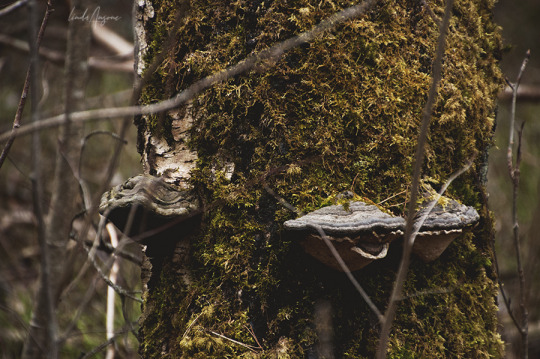
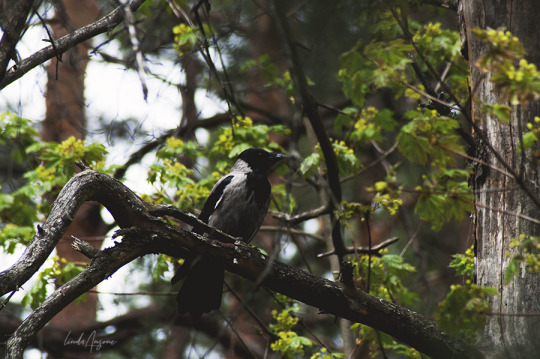




#forest#forest photography#woods#forestcore#mushrooms#fungi#fomes fomentarius#Pear-shaped puffball#Red Squirrel#hooded crow#nature#nature photography#latvia#original photographers#photographers on tumblr
453 notes
·
View notes
Photo

Pear Shaped Puffball (Lycoperdon Pyriforme)
3/14/2021
#mushrooms#fungus#nature photography#puffball#pear shaped puffball#identified#brown#yellow#spores#garvin park#garvin county park#lyon county#march
31 notes
·
View notes
Text


Tiny puffballs. Probably Lycoperdon pyriforme, the pear-shaped puffball.
#Bruce Trail#Cape Chin#Niagara Escarpment#Bruce Peninsula#Bruce County#Ontario#Canada#hiking#hiking trail#forest#trees#wilderness#outdoors#landscape#mushroom#mycology#fungus#Lycoperdon pyriforme#pear-shaped puffball#photography#digital photography#DSLR#Canon 6D#photographers on Tumblr
2 notes
·
View notes
Photo

New Fungus!
1. Pear Shaped Puffball
0 notes
Photo
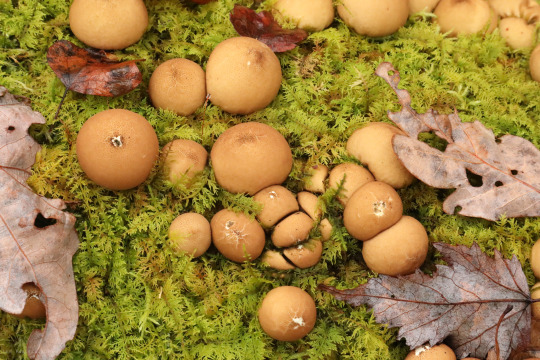
Pear-shaped puffballs (Apioperdon pyriforme) huddle in the moss in the late October woods. The central pores of some of the puffballs in this cluster have already begun to rupture and will soon release their spores.
#appalachia#vandalia#west virginia#fungi#apioperdon#pear-shaped puffball#stump puffball#coopers rock state forest#fall#autumn
124 notes
·
View notes